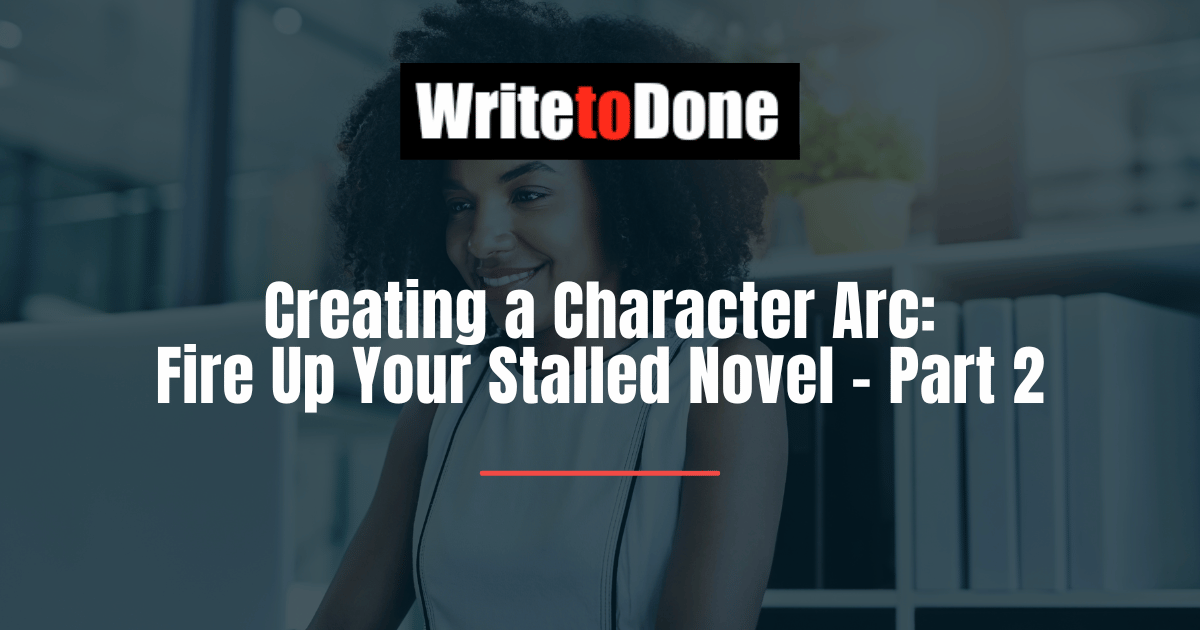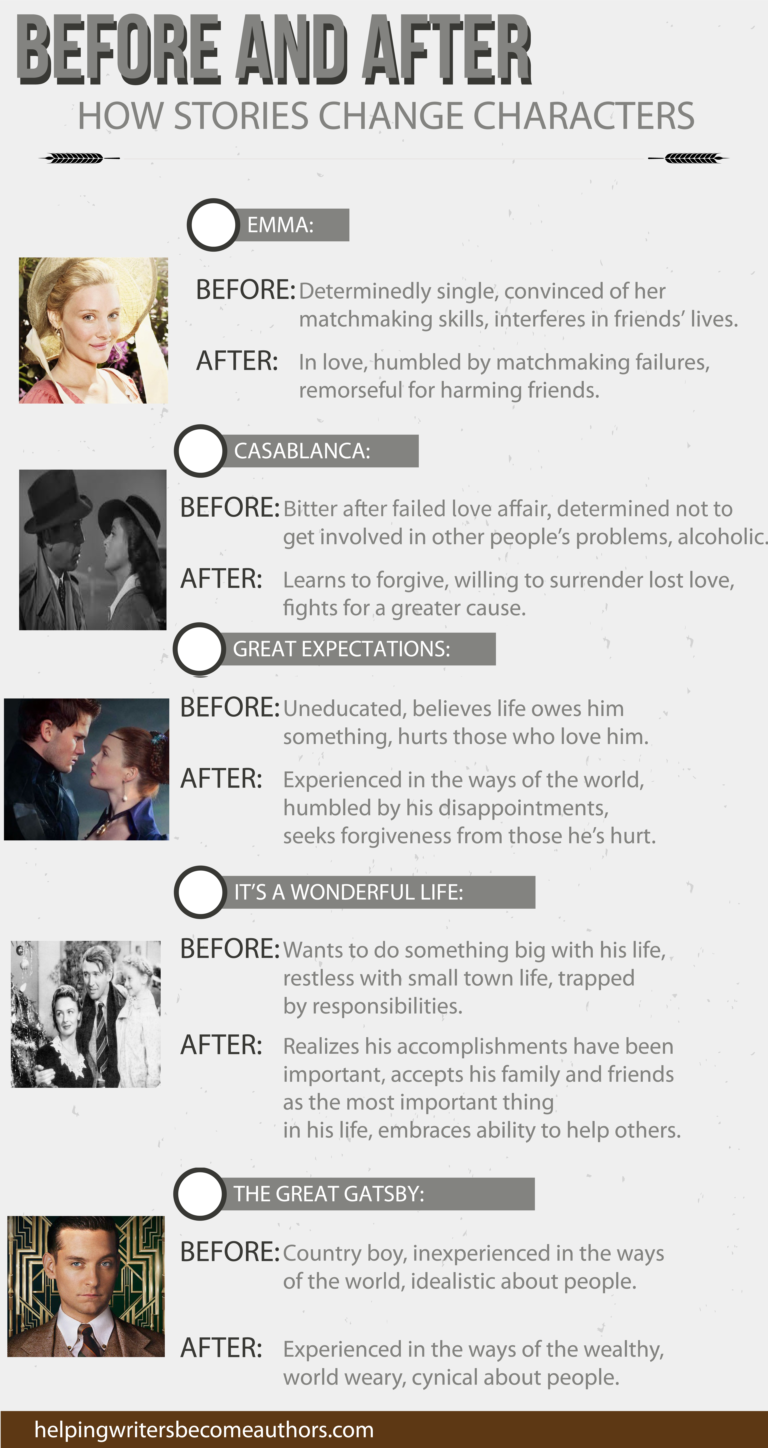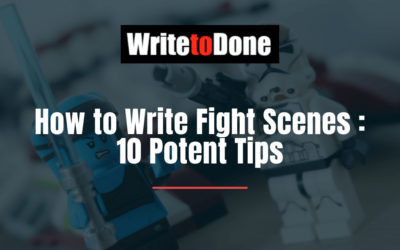Want to create characters that burrow their way into a reader’s heart? The key to devising unforgettable protagonists is creating a character arc.
More about character arcs in a moment. Let’s step back for a moment and take a birds-eye view of creating novels.
The four burning question most aspiring novelists have are:
How can I work out what to write about?
How do I create compelling characters?
How can I know whether my plot is viable or not?
How to I go about the process of writing the novel?
I wrote PART 1 of Fire Up Your Stalled Novel is in answer to the first question: How can I work out what to write about. It’s about how to figure out the story of your fledgling novel, starting from your first, fleeting idea.
The key is to start with the Idea, and then develop the Concept, the Premise, and the Theme.
Here’s a quick recap: the Idea is the initial seed of your series or novel. The Concept is a fleshed-out idea that already indicates conflict. As I explained in Fire Up Your Stalled Novel – Part 1 Think of the Concept as an elevator pitch you would use at a writer’s conference if someone asks about your series. Your answer is the Concept of your series.
The Premise is what your particular story is about. It introduces the protagonist and gives a short preview of the plot, highlighting the external conflict.
The last piece of the puzzle of finding what to write about by starting with an idea and then elaborating it is to match the Concept with the Theme. Remember, the Theme is the internal conflict of the protagonist.
I’ll talk more about Theme in a moment.
If you are confused about these terms, please read Part 1 before continuing.
In this Part 2 of How to Fire Up a Stalled Novel, the focus is on the second question, How do I create compelling characters?
The three books I’ve found most useful for this topic are:
Creating Character Arcs: The Masterful Author’s Guide to Uniting Story Structure by K. M. Weiland,
Take Off Your Pants: Outline Your Books for Faster, Better Writing by Libbie Hawker, and
Nail Your Story: Add Tension, Build Emotion, and Keep Your Readers Addicted by Monica Leonelle.
If you are serious about writing a novel, I suggest dipping into all of these books. I riffle through them every day.
Leonelle, Hawker, and Weiland all recommend basing a plot on the character arc of your main protagonist. In this way, the plot rests on the internal development of your main character.
The Finesse of Creating a Character Arc
When I first started writing my novel, I strung together external events because I thought that was the heart of plotting. However, after reading books by Monica Leonelle and Libbie Hawker, I realized that creating a character arc is the key to a great plot.
John Truby, who wrote the excellent book, The Anatomy of Story: 22 Steps to Becoming a Master Storyteller calls the character arc the dramatic code which lies at the heart of all compelling stories.
All stories are a form of communication that expresses the dramatic code. The dramatic code, embedded deep in the human psyche, is an artistic description of how a person can grow or evolve.
From: John Truby – The Anatomy of Story
The character arc is a way you protagonist moves, grows, and changes within a story. According to Leonelle, every character needs to go through a transformation, and this transformation starts off with what she calls the Fatal Flaw.
The Fatal Flaw
Every protagonist needs to be flawed.
Flaws serve to add depth and conflict, establish empathy, and make the character more memorable.
MJ Bush, Writing the Perfect Flaw
As Monica Leonelle explains, the Fatal Flaw is the BIG THING that’s wrong in your character’s life. To overcome the obstacles in their path, the protagonist must learn, grow and develop to overcome their Fatal Flaw.
The Fatal Flaw is a way of looking at the world that will change by the end of the story.
Monica Leonelle, Nail Your Story
Here is how I worked out the Fatal Flaw of Kat, my protagonist in The Brazilian Incident:
Kat can’t forgive herself for losing the daughter who was abducted and now can’t see the good in herself or others. Her Fatal Flaw is that she can’t forgive herself and distrusts everyone.
If you compare the Fatal Flaw with the Premise of my novel, The Brazilian Incident, you can immediately see how this Fatal Flaw can play out:
Kat Sylvester, whose young daughter disappeared without a trace, is reluctantly persuaded by her ex-husband to find out whether her father-in-law, David Faring, actually died seven years ago, or whether it was a cover-up and he is still alive. As she digs deep into his life, she receives mysterious threats.
To complete her quest and find out the truth about her father-in-law, Kat will have to learn to trust again and heal from her grief and guilt. As this is going to be the first novel of a series, Kat will not overcome her Fatal Flaw fully by the end of this novel, but she will have overcome some of her false beliefs and will have started her journey of healing.
You see, the way the Fatal Flaw keeps on tripping the protagonist up is by her or his False Beliefs. These are the small beliefs that hold the protagonist back from breaking through the Fatal Flaw.
Protagonists, like most people in real life, can’t see their own flaws. So they think the resulting beliefs are correct and logical, even though they are the product of their Fatal Flaw. Here are the False Beliefs of my protagonist, Kat:
‘I’m not good enough.’
‘You can’t trust anyone.’
‘You can’t get hurt if you keep your distance.’
The term ‘character arc’ implies that there is a development in play. At the beginning of the novel, the protagonist is still stuck in their Fatal Flaw but, as the story progresses, they learn to let go of some or all of the False Beliefs and finally go through a transformation which releases them (at least in part) from their Fatal Flaw.
Every character in your novel needs a Character Arc.
The Character Arc is closely allied to motivation. The outer motivation is the Big Goal, i.e., what the protagonist wants. For example, in my novel Kat wants to find the truth. She wants to know whether her father-in-law she loved is truly dead, or whether it was a cover-up and he is still alive.
The inner motivation is fuelled by unmet needs. (You can read more about this here.)
In The Brazilian Incident, Kat must heal from the trauma of losing her child. She needs to rejoin humanity by allowing herself to feel emotions again.
One of the best resources for creating character arcs is K. M. Weiland’s book Creating Character Arcs: The Masterful Author’s Guide to Uniting Story Structure. Below is her infographic on how characters change in famous stories:
In all of this, let’s not forget about the Antagonist!
Who is the Antagonist in Your Story?
Every story needs an Antagonist, a person or forces the protagonist has got to struggle against to complete her or his quest.
According to Libbie Hawker, the antagonist is the person who is most heavily invested in achieving the same external goal as the protagonist.
Once you’ve determined your Antagonist, create a character arc for him or her as well.
What to do next
After reading this article, work on your characters. Take each one in turn and determine their Fatal Flaw. Remember, the Fatal Flaw impedes the character in reaching his or her goal.
Once you’ve determined a character’s Fatal Flaw, list the resulting false beliefs.
It’s best to make a list of all your characters and write down the Fatal Flaw and Wrong Beliefs.
Then take your Protagonist, your secondary characters, and the Antagonist, creating a Character Arc for each one.
You guiding question should be: How does my protagonist’s character need to develop in the story?
In PART 3, I’ll set out exactly how to work up a compelling plot, based on your protagonist’s Character Arc.
According to Libbie Hawker, when you have a detailed, well-crafted plot outline, the actual writing of your novel can be done in weeks, not months or even years.
Remember the key to success is to read each article in this series slowly, assimilate the information, and then put it into action so that you develop a clear plot outline that will make writing your novel fast and easy.
If you have questions, please ask in the comment section below.
Fire up a Stalled Novel – Part 1: From Idea to Concept and Premise



















